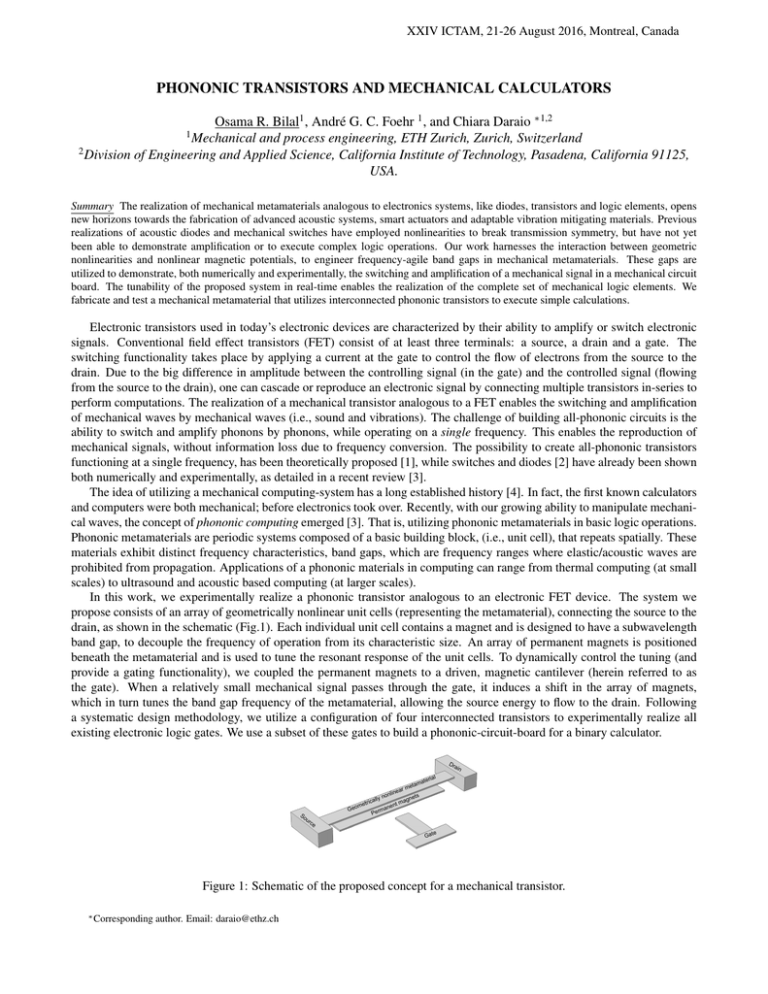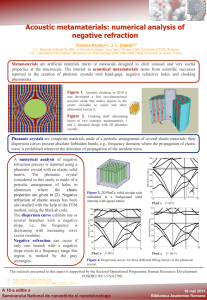PHONONIC TRANSISTORS AND MECHANICAL CALCULATORS
advertisement

XXIV ICTAM, 21-26 August 2016, Montreal, Canada PHONONIC TRANSISTORS AND MECHANICAL CALCULATORS Osama R. Bilal1 , André G. C. Foehr 1 , and Chiara Daraio ∗1,2 Mechanical and process engineering, ETH Zurich, Zurich, Switzerland 2 Division of Engineering and Applied Science, California Institute of Technology, Pasadena, California 91125, USA. 1 Summary The realization of mechanical metamaterials analogous to electronics systems, like diodes, transistors and logic elements, opens new horizons towards the fabrication of advanced acoustic systems, smart actuators and adaptable vibration mitigating materials. Previous realizations of acoustic diodes and mechanical switches have employed nonlinearities to break transmission symmetry, but have not yet been able to demonstrate amplification or to execute complex logic operations. Our work harnesses the interaction between geometric nonlinearities and nonlinear magnetic potentials, to engineer frequency-agile band gaps in mechanical metamaterials. These gaps are utilized to demonstrate, both numerically and experimentally, the switching and amplification of a mechanical signal in a mechanical circuit board. The tunability of the proposed system in real-time enables the realization of the complete set of mechanical logic elements. We fabricate and test a mechanical metamaterial that utilizes interconnected phononic transistors to execute simple calculations. Electronic transistors used in today’s electronic devices are characterized by their ability to amplify or switch electronic signals. Conventional field effect transistors (FET) consist of at least three terminals: a source, a drain and a gate. The switching functionality takes place by applying a current at the gate to control the flow of electrons from the source to the drain. Due to the big difference in amplitude between the controlling signal (in the gate) and the controlled signal (flowing from the source to the drain), one can cascade or reproduce an electronic signal by connecting multiple transistors in-series to perform computations. The realization of a mechanical transistor analogous to a FET enables the switching and amplification of mechanical waves by mechanical waves (i.e., sound and vibrations). The challenge of building all-phononic circuits is the ability to switch and amplify phonons by phonons, while operating on a single frequency. This enables the reproduction of mechanical signals, without information loss due to frequency conversion. The possibility to create all-phononic transistors functioning at a single frequency, has been theoretically proposed [1], while switches and diodes [2] have already been shown both numerically and experimentally, as detailed in a recent review [3]. The idea of utilizing a mechanical computing-system has a long established history [4]. In fact, the first known calculators and computers were both mechanical; before electronics took over. Recently, with our growing ability to manipulate mechanical waves, the concept of phononic computing emerged [3]. That is, utilizing phononic metamaterials in basic logic operations. Phononic metamaterials are periodic systems composed of a basic building block, (i.e., unit cell), that repeats spatially. These materials exhibit distinct frequency characteristics, band gaps, which are frequency ranges where elastic/acoustic waves are prohibited from propagation. Applications of a phononic materials in computing can range from thermal computing (at small scales) to ultrasound and acoustic based computing (at larger scales). In this work, we experimentally realize a phononic transistor analogous to an electronic FET device. The system we propose consists of an array of geometrically nonlinear unit cells (representing the metamaterial), connecting the source to the drain, as shown in the schematic (Fig.1). Each individual unit cell contains a magnet and is designed to have a subwavelength band gap, to decouple the frequency of operation from its characteristic size. An array of permanent magnets is positioned beneath the metamaterial and is used to tune the resonant response of the unit cells. To dynamically control the tuning (and provide a gating functionality), we coupled the permanent magnets to a driven, magnetic cantilever (herein referred to as the gate). When a relatively small mechanical signal passes through the gate, it induces a shift in the array of magnets, which in turn tunes the band gap frequency of the metamaterial, allowing the source energy to flow to the drain. Following a systematic design methodology, we utilize a configuration of four interconnected transistors to experimentally realize all existing electronic logic gates. We use a subset of these gates to build a phononic-circuit-board for a binary calculator. Figure 1: Schematic of the proposed concept for a mechanical transistor. ∗ Corresponding author. Email: daraio@ethz.ch We calculate the band structure of an infinite array of unit cells using the finite element method, by solving the elastic wave equations and Bloch wave formulation and considering the wave propagation along the direction of periodicity (i.e., ΓX direction). We characterize the system experimentally by fixing one end of the finite metamaterial structure to the source (i.e., a mechanical shaker) and the other end to the drain (a fixed, rigid support). The signal at the drain is measured using a laser Doppler vibrometer. The numerically obtained dispersion curves of the infinite media is shown in Fig. 2 (left). The experimental characterization of the frequency response function of a 5 unit cell finite metamaterial is shown in Fig. 2 (right). Theory and experiments agree well, particularly in the band gap frequency range, highlighted in gray. Figure 2: (Left) Numerically obtained dispersion curves in the Γ X direction of the metamaterial. (Right) Experimentally obtained frequency response function of a metamaterial consisting of 5 unit cells. The band gap region is highlighted in gray in both panels. We demonstrate the switching ability of the fabricated system in Figure 3. We measure the mechanical signal at the drain when the gate is open, allowing the signal to pass, (Fig. 3 left) and when the gate is closed (Fig. 3 right). The amount of energy flowing from the source to the drain when the gate is closed is on the same order of magnitude as the laser vibrometer noise level, while the difference in magnitude between the two states, ON and OFF, is bigger than a factor of 5. It is important to mention that the switching response can be triggered dynamically, driving the gate cantilever at its resonant frequency. We also measure the signal amplification as a ratio of the amplitude of source signal to the gate signal. From numerical data and experimental results, not shown, the amplification reached by our system is 10. The combination of real-time switching and amplification shows the realization of a mechanical transistor analogous to an electronic FET. The realization of basic logic gates, namely, OR, AND, XOR, XNOR, NAND, NOR and NOT can easily follow. We utilize the proposed framework to realize the circuit board of a phononic calculator. Figure 3: Time series of the mechanical signal at the drain when the system is ON (left) and OFF (right). ACKNOWLEDGMENT: This work was partially supported by the ETH Postdoctoral Fellowship FEL-26 15-2 to the first author. References [1] Malishava M., and Ramaz K.: All-Phononic Digital Transistor on the Basis of Gap-Soliton Dynamics in an Anharmonic Oscillator Ladder. Phys Rev Lett 115.10 (2015): 104301. Liang, B., et al. ”Acoustic transistor: Amplification and switch of sound by sound.” Appl Phys Lett 105.8 (2014): 083510. [2] Boechler, N., et al. ”Bifurcation-based acoustic switching and rectification.” Nature materials 10.9 (2011): 665-668. Devaux, Thibaut, et al.:Asymmetric acoustic propagation of wave packets via the self-demodulation effect. Phys Rev Lett 115.23 (2015): 234301. [3] Sklan, S. R.: Splash, pop, sizzle: Information processing with phononic computing. AIP Adv 5.5 (2015): 053302. [4] Freeth, Tony, et al.: Decoding the ancient Greek astronomical calculator known as the Antikythera Mechanism. Nature 444.7119 (2006): 587-591.


